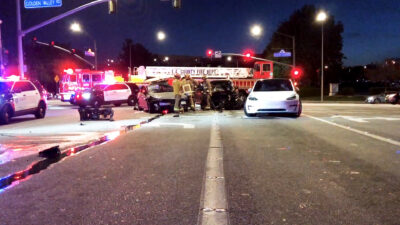Santa Clarita Valley residents are also no stranger to seeing pictures of super tankers filling up at Castaic Lake, or seeing convoys of fire engines and vehicles streaking down the street.
The U.S. Forest Service has over 200 or so terms they use. The National Wildfire Coordinating Group, a conglomerate of multiple fire organizations, including the Forest Service, has over 2,476.
Here are a few important terms to know, courtesy of a list compiled with the help of Maria Grycan, a spokeswoman for the Los Angeles County Fire Department, and fire Capt. Ronald Haralson.
The terms
The following is a list of terms that are important to know, with each term having particular significance during an active incident.
Fire line — “The perimeter of the fire, or part of a control line that is scraped or dug down to mineral soil.”
A fire line is created through the use of manpower and ground-level engine power. Firefighters creating the line, also known as “punching line,” can use picks, chainsaws, shovels and other foliage cutting/removing tools to create the fire line.
Containment — “Usually expressed as a percentage, it is the portion of the fire line around which we have contained the fire within.”
A containment percentage does not mean the fire is out, Grycan and Haralson emphasized, but rather, it means that the fire is contained within that area at the fire line.
“If you were to look at a current PIO map of the Lake Fire, you will see that, around the perimeter of the fire, there is BLACK line,” said Haralson. “That is the area of the fire that is now contained. The remainder of the fire is considered ‘open line,’ and where the priority is to build more containment line. As containment goes up, more black line appears on the map.”
When a brush fire goes out, there is a standard procedure that firefighters follow when declaring the response needed, according to Grycan and Haralson. These fall along the lines of first alarm, second alarm and third alarm.
First alarm (115 responding personnel) — Seven engines, one brush patrol, three helicopters with one crew, four camp crews, one dozer team, one water tender, three superintendents, two super scoopers (during certain months), one preventative maintenance squad, two battalion chiefs and one Los Angeles Fire Department helicopter.
Second alarm (195 responding personnel) — 12 engines, one brush patrol, three helicopters with one crew, eight camp crews, two dozer teams, two water tenders, three superintendents, two super scoopers (during certain months), one preventative maintenance squad, one heavy equipment superintendent, one helitender, one emergency support unit, one assistant chief, four battalion chiefs and one Los Angeles Fire Department helicopter.
Third alarm (228 responding personnel) — 22 engines, one brush patrol, three helicopters with one crew, eight camp crews, two dozer teams, two water tenders, three superintendents, two Super Scoopers (during certain months), one preventative maintenance squad, one heavy equipment superintendent, one helitender, one emergency support unit, one assistant chief, deputy chief, six battalion chiefs and one Los Angeles County Fire Department helicopter.
Then comes the terms that are called out during the fire outside of the alarms, such as structures threatened and/or destroyed, and fuel type.
Structures threatened — Any homes, commercial, or other structures (outbuildings, sheds, detached garages, etc.) that are in or may potentially be in the path of the fire.
“The number of structures threatened does not necessarily equate to the number of structures evacuated,” said Haralston. “The total number of structures threatened is usually higher. For example, it is feasible that we can have structures threatened without ever having to initiate evacuations. During the Lake Fire, we had over 1,300 structures threatened, but our evacuation orders affected just under 300 homes.”
There are a variety of vehicles that can be used, according to Grycan and Haralson, when battling a fire.
Fire officials often transport hand crews that work close to the fire’s edge on the ground with hand tools. They coordinate attacks with the water dropping helicopters in the air and the engine crews running hose lines, Haralson said. Bulldozers also work to create “fuel breaks” or perimeter lines around the fire or in defense of a structure, Haralson added.
When there isn’t water, or where the fire retardant known as PhosChek is considered more effective, it’s used to cover an area in “pink dust.”
PhosChek — “That is a fire retardant called PhosChek, and is considered to be an indirect attack,” said Haralson. “That is, PhosChek is dropped ahead of a fire, not directly onto the fire. It is used as a fire break to slow/stop the spread. Direct attack from the air is the water that is dropped from helicopters, as that is dropped directly onto the fire.”
The last bit of knowledge crucial to the understanding of basic aspects to wildland fires is: “What is the worst-case scenario when firefighters arrive on the scene?”
One of the worst-case scenarios is when a fire is moving uphill, because it travels at a much faster rate uphill then it does downhill.
“So in that respect, it is worse, because it would be more difficult to contain,” said Haralson. “I seem to remember that this Lake Fire was a bit challenging in the beginning because as units arrived, the fire was coming toward them, so they had to work their way around to a safer location from which to begin working.”













